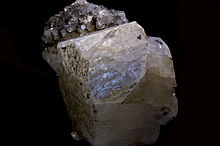Moonstone (gemstone)
| Moonstone | |
|---|---|
 | |
| General | |
| Category | Orthoclase variety |
| Formula (repeating unit) | (Na,K)AlSi3O8 |
| Identification | |
| Color | Can be numerous colors, including blue, grey, white, pink, peach, green and brown, as well as colorless |
| Fracture | uneven to conchoidal |
| Mohs scale hardness | 6.0 |
| Luster | Opalescent |
| Streak | white |
| Specific gravity | 2.61 |

Moonstone is a sodium potassium aluminium silicate ((Na,K)AlSi3O8) of the feldspar group that displays a pearly and opalescent schiller.[1][2] An alternative name is hecatolite.[2]
Etymology[]
Its name is derived from a visual effect, sheen or schiller (adularescence), caused by light diffraction within a micro-structure consisting of regular exsolution layers (lamellae) of different alkali feldspars (orthoclase and sodium-rich plagioclase).
History[]
Moonstone has been used in jewelry for millennia, including ancient civilizations. The Romans admired moonstone, as they believed it was derived from solidified rays of the Moon.[3] Both the Romans and Greeks associated moonstone with their lunar deities. In more recent history, moonstone became popular during the Art Nouveau period; French goldsmith René Lalique and many others created a large quantity of jewelry using this stone.[4]
Geology[]
The most common moonstone is of the orthoclase feldspar mineral adularia, named for an early mining site near Mt. Adular in Switzerland, now the town of St. Gotthard.[1] A solid solution of the plagioclase feldspar oligoclase +/− the potassium feldspar orthoclase also produces moonstone specimens.
Occurrence[]

Deposits of moonstone occur in Armenia (mainly from Lake Sevan), Australia, the Austrian Alps, Mexico, Madagascar, Myanmar, Norway, Poland, India, Sri Lanka[5] and the United States.[2]
In popular culture[]
The moonstone is the Florida State Gemstone; it was designated as such in 1970 to commemorate the Moon landings, which took off from Kennedy Space Center. Despite it being the Florida State Gemstone, it does not naturally occur in the state.[6]
Moonstone or moonstone gems have been used frequently in many supernatural applications, particularly in pop culture, such as in The Vampire Diaries. Most often in stories about supernatural vampires or werewolves, moonstones have been depicted as either enhancing or suppressing the abilities of supernatural creatures.
References[]
- ^ Jump up to: a b Moonstone Gemological Information International Gem Society, Retrieved 01-05-15
- ^ Jump up to: a b c Moonstone on Mindat.org
- ^ "Moonstone" American Gem Trade Association. Retrieved 21 January 2011.
- ^ "Moonstone" International Colored Gemstone Association. Retrieved 26 April 2012.
- ^ "Moonstone" Encyclopædia Britannica, 2011. Web. 20 Jan. 2011.
- ^ "Moonstone – Florida State Symbols". Florida Division of Historical Resource. Retrieved 1 Sep 2011.
External links[]
 Media related to Moonstone at Wikimedia Commons
Media related to Moonstone at Wikimedia Commons
- Feldspar
- Gemstones
- Symbols of Florida
